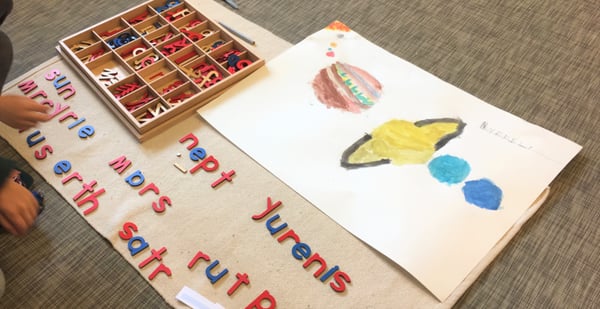As part of our study of the solar system in the Acton Montessori studio, children learned about Curiosity, the rover that NASA sent to Mars in 2011 to get information about the red planet. “Curiosity” was a new word for many of the learners, and guides discussed with them that it means to wonder and want to know more about something. Then learners shared things that they were curious about. “I’m curious about why an asteroid hit the Earth,” said one learner. “I’m curious about why Mars is red,” said another.
Kristen Wall
Recent Posts

Young children are learning how to hear and reproduce the sounds of spoken language. In order to write, they need to know how to break down words into phonemes, the small units of sound we associate with letters and combinations of letters.
Opportunities for rhyming help learners isolate different chunks of sounds. In the studio, we sing songs like “Down by the Bay” or “Willoughby Wallaby Woo,” which are fun for learners and help them hear the component parts of words. If you’d like to sing at home, it goes like this:
Willoughby wallaby wusan,
An elephant sat on Susan!
Willoughby wallaby wack,
An elephant sat on Jack!
This week learners also enjoyed singing Apples and Bananas, which helps children hear long and short vowel sounds.
I like to eat, eat, eat apples and bananas
I like to eat, eat, eat apples and bananas
I like to ate, ate, ate ay-ples and ba-nay-nays
I like to ate, ate, ate ay-ples and ba-nay-nays
I like to eat, eat, eat ee-ples and bee-nee-nees
I like to eat, eat, eat ee-ples and bee-nee-nees
Etc.
Enjoy these silly songs with your learner!
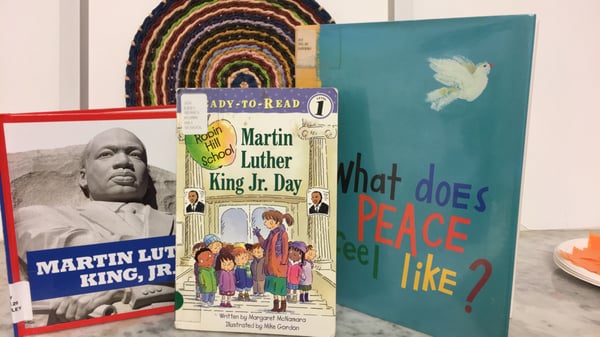
In honor of the Martin Luther King, Jr. holiday, we are reading books about King’s life and legacy. The holiday provides an opportunity to discuss concepts such as respect and kindness and to discuss how we like to be treated and how we should treat each other. Learners gave examples of ways they like and don’t like to be treated. One learner shared, “I like it when my friends ask me to play with them.” “Someone gave me a fluffy toy when I fell outside a hotel,” said another.
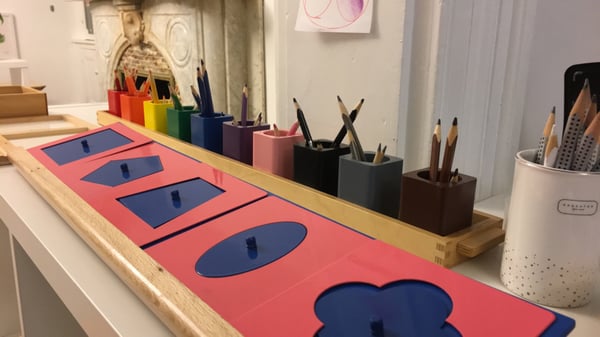
One of the fundamental aspects of the Montessori studio is the focus on order. The materials on the shelves are arranged in order from least to most complex, and work is stored in the same place (and, in some instances, in a particular sequence). From an outside perspective, the high value given to order might seem unusual or quaint. However, order is the basis for all the learning that happens in the studio. The child mentally absorbs his physical environment, and the physical environment helps a child organize her behaviors and her mind.
Order paves the way for a child to begin to focus and concentrate on activities in the classroom. When they know what to expect, where to find the materials that they need, and what is expected of them, children are freed to explore and can develop independence from adults.
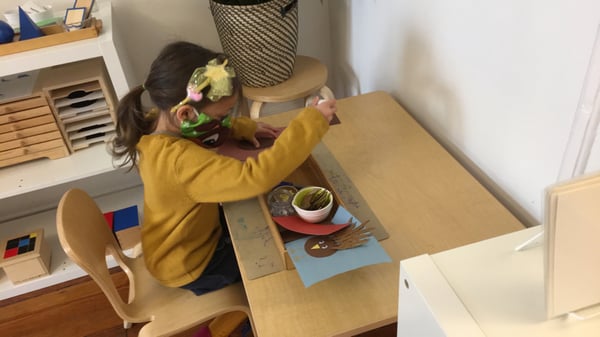
The beautiful foliage over the past few weeks has provided a wonderful opportunity for learners to notice the natural world and study leaves and trees. Learners have been examining the parts of a leaf, including the veins, blade, and petiole (the stem we can hold), and are identifying the shapes of different types of leaves, such as elm, oak, and ginkgo. Learners are practicing sorting leaves by color and matching similar shapes. Learners have also been examining types of bark and colors of wood from different trees. On the art shelf, learners are making leaf art with watercolors, leaf rubbings, and other materials. On the art shelf, learners are making leaf art, including painting with watercolors on leaf rubbings.
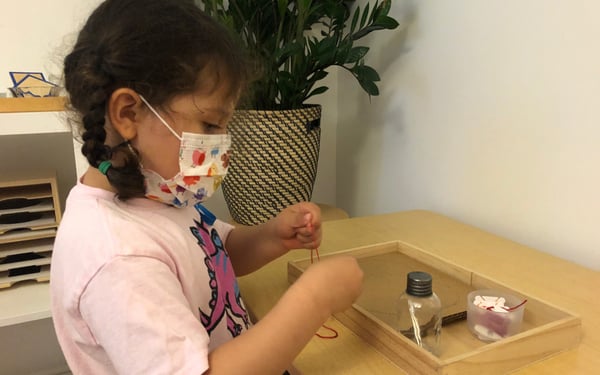
One of the main tasks the Montessori studio aims to accomplish is preparing a child’s hand for the task of writing. Writing requires a number of fine motor skills, including the strength and coordination of the thumb and first two fingers to hold the pencil securely in a ‘pincer grip’, the hand-to-eye coordination to trace visual or imagined shapes, and the flexibility of the wrist to move back and forth to allow for subtler movement in shaping letters and numbers.
Many materials and activities in the classroom are designed to strengthen these fine motor skills throughout the Montessori primary cycle. Introductory Montessori materials like the knobbed cylinders and puzzles have small knobs that require a child to form a pincer grip and lift weighted objects, strengthening those fingers in the process. The Practical Life area is full of opportunities for a child in the first year of Montessori to practice using small spoons and stiff tongs to transfer small objects, which also strengthen the fingers and hand-to-eye coordination. Young learners are also tracing sandpaper letters and numbers to start to get a kinetic feel for the shapes of the letters.
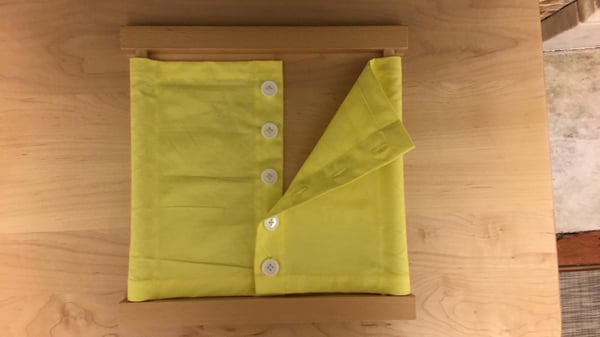
As we transition into fall, more jackets, hats, and mittens are appearing in the studio! As part of the Montessori Practical Life curriculum, young learners have opportunities to practice putting on their own coats, mittens, and hats before playing outside.
In the studio, Montessori “dressing frames” help learners practice these practical fine motor skills as part of the morning work cycle. There are dressing frames for zippers, small and large buttons, buckles, and laces. Over the three-year Montessori primary cycle, learners progressively master these different types of clothing fasteners, helping them to be more independent at home and school. The older learners also exercise their leadership and mentorship skills during transitions, as they love to help younger ones zip up and buckle up too.
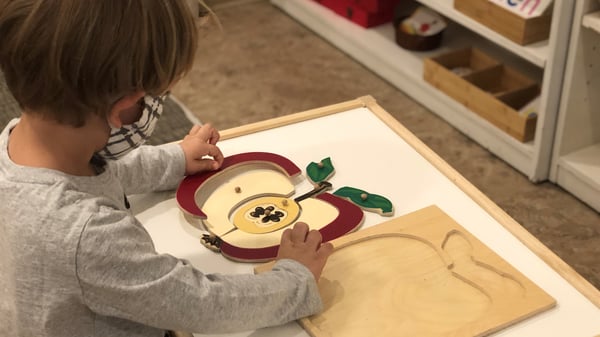
This year in the Montessori studio we will be holding observations by Zoom, which might be a first for a Montessori observation! While a virtual observation might not allow parents to see the entire studio, it does give parents an opportunity to be the proverbial fly on the wall and see a normal day in the life of your child. It will also give you a more uninterrupted, close-up view of your child than you might be able to have otherwise.
The Montessori method is founded on observation. As guides, we regularly step back to observe children working. We call it an observation and not an evaluation because we are seeking to learn and gain insight about the child through her behavior. We are looking at the type of work a child is inclined towards, how a child is processing information and interacting with the environment, and how a particular child learns.
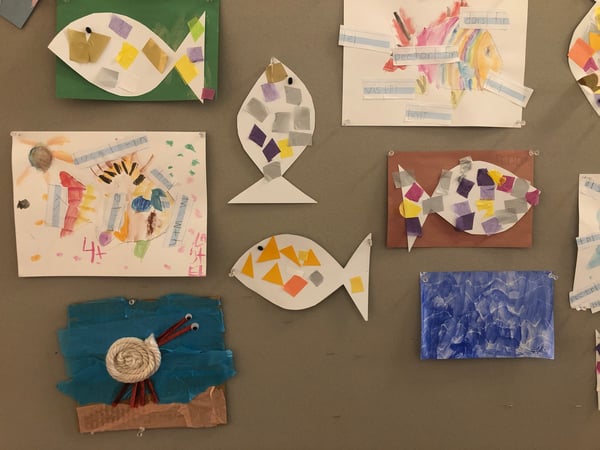
What can we learn about friendship from the goby fish and the pilot shrimp? Quite a lot, it turns out! Afternoon learners are finishing their study of coral reefs with a focus on symbiotic relationships. Animals like the goby fish and the pilot shrimp keep each other safe and provide access to food by helping each other out in special ways.
Just like the goby fish and the pilot shrimp, learners help each other in many ways. Group time is one of the times that learners share how they are helping each other. This morning an older learner told the studio, “I helped [a younger learner] put his backpack in his cubby.” Younger learners love to help in a number of ways, such as bringing a pencil or material to a friend during the work period, or holding the gate open for other learners to enter the playground.
As part of the Montessori curriculum, we offer many group “grace and courtesy” lessons to help the learners develop prosocial skills and learn how to be a friend and a peaceful member of the community. We often introduce grace and courtesy lessons through role-playing, and invite each learner to take a turn practicing what to do and say in different scenarios. Children learn to ask questions such as “Would you like some help?” or “Excuse me, could you help me?” or “Could I use that when you are finished?”

Never help a child at a task at which he feels he can succeed.
— Dr. Maria Montessori
As Montessorians, we are looking for every opportunity to empower children to be independent. A child’s self-confidence arises when she genuinely masters a challenging task. In the last week we have seen many beaming faces showing us deepening self-confidence and independence. From the new child who overcame her fear of climbing the two big steps to the sink, to the returning learner who composes new words independently with the moveable alphabet, to the kindergartener who counted all the way to 125 on the bead chain, all showed the same pride when they realized they could accomplish something they couldn’t do before!
When we set up the studio before school starts, we are always thinking about how the environment sets learners up for independence. Are the towels to wipe up spills available in an accessible place for a child? Is the paper on the top shelf within reach so a child can get it himself without asking for help? The underlying question we are always asking is: are we setting up children to be dependent on us or independent?
